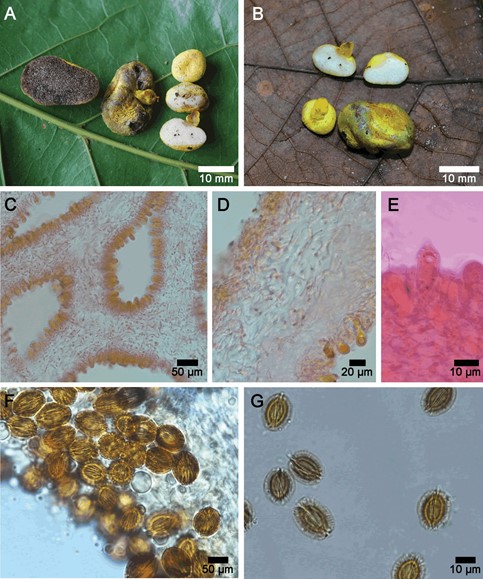Longistriata Sulzbacher, Orihara, Grebenc, M.P. Martín & Baseia, gen. nov.
Index Fungorum number: MB 816322; Facesoffungi number: FoF
Etymology: Longis (Latin), with or from the long; striatus (Latin), striate, fluted; in reference to the distinctive series of thin longitudinal striations on the surface of the basidiospores.
Diagnosis: Distinguished from other genera in Boletaceae by a combination of the following characters: Basidiomata hypogeous to subhypogeous, sequestrate, subglo- bose, with a short stipe (Fig. 3A–B). Peridium bright yellow, smooth, with a cutis of interwoven and gelatinized inflated hyphae. Subgelatinous sterile base (a short stipe) present. Gleba loculate, white when immature to yellowish brown at maturity, turn- ing dark green to black when cut in older basidioma, columella absent. Basidiospores broadly ellipsoid, hyaline to light brown at maturity, dextrinoid, with a series of thin, irregular longitudinal ridges across the spore surface; in some places these ridges are fused together. Cystidia are lageniform with rounded apices. Clamp connections ab- sent. Found in white sand habitat in tropical ectotrophic forests. Potentially mycor- rhizal with tropical ectomycorrhizal plants from genera Coccoloba (Polygonaceae) and Guapira (Nyctaginaceae).
Type species: Longistriata flava Sulzbacher, Orihara, Grebenc, M.P. Martín & Ba- seia, sp. nov.

Figure 3. A–G Longistriata flava (UFRN-Fungus1756, holotype) A–B fresh mature basidioma C hyme- nophoral trama mounted in 3% KOH with Congo Red D interwoven hyphae of peridium (upper left) and hymenophoral trama mounted in 3% KOH with Congo Red E hymenial cystidia mounted in 3% KOH with Congo Red F basidiospores mounted in Melzer’s reagent G basidiospores mounted in 3% KOH.
Species
